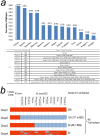Genome sequencing and analysis of BCG vaccine strains
- PMID: 23977002
- PMCID: PMC3747166
- DOI: 10.1371/journal.pone.0071243
Genome sequencing and analysis of BCG vaccine strains
Abstract
Background: Although the Bacillus Calmette-Guérin (BCG) vaccine against tuberculosis (TB) has been available for more than 75 years, one third of the world's population is still infected with Mycobacterium tuberculosis and approximately 2 million people die of TB every year. To reduce this immense TB burden, a clearer understanding of the functional genes underlying the action of BCG and the development of new vaccines are urgently needed.
Methods and findings: Comparative genomic analysis of 19 M. tuberculosis complex strains showed that BCG strains underwent repeated human manipulation, had higher region of deletion rates than those of natural M. tuberculosis strains, and lost several essential components such as T-cell epitopes. A total of 188 BCG strain T-cell epitopes were lost to various degrees. The non-virulent BCG Tokyo strain, which has the largest number of T-cell epitopes (359), lost 124. Here we propose that BCG strain protection variability results from different epitopes. This study is the first to present BCG as a model organism for genetics research. BCG strains have a very well-documented history and now detailed genome information. Genome comparison revealed the selection process of BCG strains under human manipulation (1908-1966).
Conclusions: Our results revealed the cause of BCG vaccine strain protection variability at the genome level and supported the hypothesis that the restoration of lost BCG Tokyo epitopes is a useful future vaccine development strategy. Furthermore, these detailed BCG vaccine genome investigation results will be useful in microbial genetics, microbial engineering and other research fields.
Conflict of interest statement
Figures




Similar articles
-
Impact of in vitro evolution on antigenic diversity of Mycobacterium bovis bacillus Calmette-Guerin (BCG).Vaccine. 2014 Oct 14;32(45):5998-6004. doi: 10.1016/j.vaccine.2014.07.113. Epub 2014 Sep 6. Vaccine. 2014. PMID: 25211768 Free PMC article.
-
Listeria-Vectored Multiantigenic Tuberculosis Vaccine Enhances Protective Immunity against Aerosol Challenge with Virulent Mycobacterium tuberculosis in BCG-Immunized C57BL/6 and BALB/c Mice.mBio. 2022 Jun 28;13(3):e0068722. doi: 10.1128/mbio.00687-22. Epub 2022 Jun 1. mBio. 2022. PMID: 35642945 Free PMC article.
-
Characterization of a cross-reactive, immunodominant and HLA-promiscuous epitope of Mycobacterium tuberculosis-specific major antigenic protein PPE68.PLoS One. 2014 Aug 19;9(8):e103679. doi: 10.1371/journal.pone.0103679. eCollection 2014. PLoS One. 2014. PMID: 25136958 Free PMC article.
-
Genome wide approaches discover novel Mycobacterium tuberculosis antigens as correlates of infection, disease, immunity and targets for vaccination.Semin Immunol. 2018 Oct;39:88-101. doi: 10.1016/j.smim.2018.07.001. Epub 2018 Jul 7. Semin Immunol. 2018. PMID: 30327124 Review.
-
[Efficacy and safety of vaccines against tuberculosis in the relation to genetic variability of Mycobacterium bovis BCG strains].Przegl Epidemiol. 2011;65(4):621-8. Przegl Epidemiol. 2011. PMID: 22390050 Review. Polish.
Cited by
-
SMRT genome assembly corrects reference errors, resolving the genetic basis of virulence in Mycobacterium tuberculosis.BMC Genomics. 2017 Apr 17;18(1):302. doi: 10.1186/s12864-017-3687-5. BMC Genomics. 2017. PMID: 28415976 Free PMC article.
-
Pan and Core Genome Analysis of 183 Mycobacterium tuberculosis Strains Revealed a High Inter-Species Diversity among the Human Adapted Strains.Antibiotics (Basel). 2021 Apr 28;10(5):500. doi: 10.3390/antibiotics10050500. Antibiotics (Basel). 2021. PMID: 33924811 Free PMC article.
-
Genomic analysis of a Mycobacterium bovis bacillus [corrected] Calmette-Guérin strain isolated from an adult patient with pulmonary tuberculosis.PLoS One. 2015 Apr 13;10(4):e0122403. doi: 10.1371/journal.pone.0122403. eCollection 2015. PLoS One. 2015. PMID: 25876043 Free PMC article.
-
First insight into the whole-genome sequence variations in Mycobacterium bovis BCG-1 (Russia) vaccine seed lots and their progeny clinical isolates from children with BCG-induced adverse events.BMC Genomics. 2020 Aug 18;21(1):567. doi: 10.1186/s12864-020-06973-5. BMC Genomics. 2020. PMID: 32811436 Free PMC article.
-
Progressive Host-Directed Strategies to Potentiate BCG Vaccination Against Tuberculosis.Front Immunol. 2022 Jul 28;13:944183. doi: 10.3389/fimmu.2022.944183. eCollection 2022. Front Immunol. 2022. PMID: 35967410 Free PMC article. Review.
References
-
- Hoft DF (2008) Tuberculosis vaccine development: goals, immunological design, and evaluation. The Lancet 372: 164–175. - PubMed
-
- Liu J TV, Leung AS, Alexander DC, Zhu B (2009) BCG vaccines: their mechanisms of attenuation and impact on safety and protective efficacy. Hum Vaccin 5: 70–78. - PubMed
-
- Seki M, Honda I, Fujita I, Yano I, Yamamoto S, et al. (2009) Whole genome sequence analysis of Mycobacterium bovis bacillus Calmette-Guerin (BCG) Tokyo 172: A comparative study of BCG vaccine substrains. Vaccine 27: 1710–1716. - PubMed
-
- Fine PE, Carneiro IA, Milstien JB, Clements CJ (1999) Issues relating to the use of BCG in immunization programmes: a discussion document. iii, 42 p.
-
- Takeya K, Shimotori S, Taniguchi T, Nomoto K (1977) Cellular Mechanisms in the Protection against Infection by Listeria monocytogenes in Mice. J Gen Microbiol 100: 373–379. - PubMed
Publication types
MeSH terms
Substances
LinkOut - more resources
Full Text Sources
Other Literature Sources
Molecular Biology Databases

